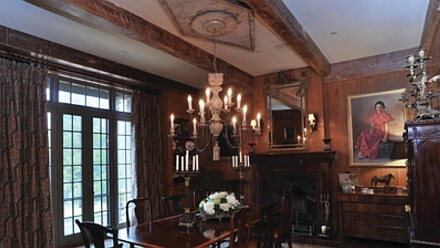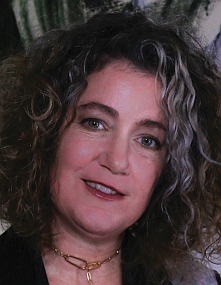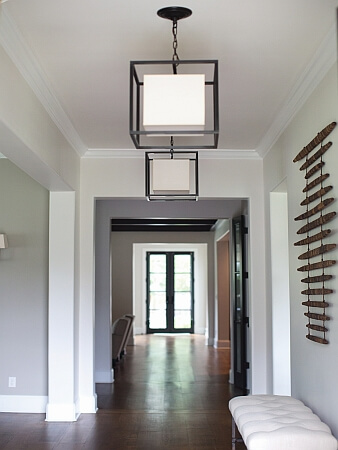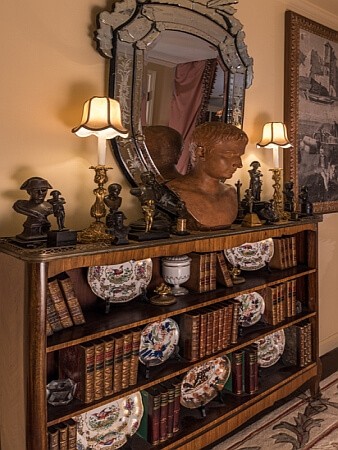As we “fall back” this time of year, shorter days lead to less sunlight and darker, earlier evenings and lighting our homes will become more important. This month, our design experts advise on the most effective lighting plans for your home, including which kind of bulbs to use!Lesley Harris Colvett

JIM HERBST
Jim Herbst
Interior Design
901-485-1259
Email Me

With the approach of early sunsets and favorite holiday evenings, there is nothing more inviting than the coziness and romance of home and hearth. Achieving that warm feel with dimly-lit rooms is of course, relatively easy with the use of rheostats (dimmer switches), which are available at home supply stores, and a must for all overhead lighting, chandeliers and track lights. Rheostats can be installed on most any lamp at a local lamp repair shops. A little pricey, but well worth the effort. Three-way bulbs are a nice alternative but burn out quickly, and a bit difficult to adjust to desired brightness.
Dimmer cords that access 3 to 4 lamps are also available at home supply stores. This is a budget-minded alternative to installing dimmers on individual lamps. Battery powered candles have become a safe and aesthetic alternative to the real candle flame and are readily available at home décor stores.
Having set the scene for a cozy winter evening, it is time for homework; it is the morning after. Newly-designed eco-smart, LED bulbs are available for recessed (cans) ceiling lights. The bulbs have a light diffusing lens that broadcasts the light into the room rather than allow it to “bounce” off surfaces. This bulb may be used with the dim or bright diffuser switch. These bulbs are expensive and available at home supply stores and online. As in all LED bulbs, they will last for a very long time. The daylight choice seems to be a more pleasing light rather than the bright white. Most any purchase of bulbs has various selections of color brightness, the warm or soft white selection seem to be the most pleasing choice. The bright white evokes a blue, fluorescent, commercial type light, which is great for work space areas.
The recently marketed vintage “Edison” bulbs are a modern touch for exposed bulbs. Clear bulbs in chandeliers dim nicely to a flame appearance, rather than a frost look. The “dixie cone” swirl bulb is taboo to most designers.
Lighting can make or break a beautifully designed home. Lighting is the frame on the painting. When possible, consult with a design professional in order to create a lighting plan for your personal taste – both indoors and out.
Dimmer cords that access 3 to 4 lamps are also available at home supply stores. This is a budget-minded alternative to installing dimmers on individual lamps. Battery powered candles have become a safe and aesthetic alternative to the real candle flame and are readily available at home décor stores.
Having set the scene for a cozy winter evening, it is time for homework; it is the morning after. Newly-designed eco-smart, LED bulbs are available for recessed (cans) ceiling lights. The bulbs have a light diffusing lens that broadcasts the light into the room rather than allow it to “bounce” off surfaces. This bulb may be used with the dim or bright diffuser switch. These bulbs are expensive and available at home supply stores and online. As in all LED bulbs, they will last for a very long time. The daylight choice seems to be a more pleasing light rather than the bright white. Most any purchase of bulbs has various selections of color brightness, the warm or soft white selection seem to be the most pleasing choice. The bright white evokes a blue, fluorescent, commercial type light, which is great for work space areas.
The recently marketed vintage “Edison” bulbs are a modern touch for exposed bulbs. Clear bulbs in chandeliers dim nicely to a flame appearance, rather than a frost look. The “dixie cone” swirl bulb is taboo to most designers.
Lighting can make or break a beautifully designed home. Lighting is the frame on the painting. When possible, consult with a design professional in order to create a lighting plan for your personal taste – both indoors and out.

ANTHONY SHAW
Anthony Shaw
Antiques & Jewelry
Chickasaw Oaks Plaza
3092 Poplar Ave, #7
Memphis, TN. 38111
901.454.6200
Email Me

Spring and Summer brings more carefree light-filled days. Fall and Winter has a tendency to be more brooding and serious, therefore the lightning needs to kick up a few notches.
But, as always in the design field, it is based on your client’s personality. Some people wish to have the same amount of bright, sun-drenched room type of light in the winter as in the summer. Others transition to warmer, lower light. However, I suggest dimmers for all of my clients. Dimmers can take the room from a bright light down to warm and cozy with ease.
Accessory lighting – as in lamps – provides a great source of coziness and can be further enhanced with 3-way bulbs that range from low, medium, and high brightness. It’s quite alright to switch out shades seasonally also. I’ve taken a silk parchment shade from summer to a black or dark-colored shade for the same lamp into fall and winter; the colors are endless.
Soft lighting with table and floor lamps are so important. Lamps needs to be near areas where one might sit to read. I always like to leave one lamp on so when I come in to a room at night it feels more welcoming. I use soft, pink light bulbs and I love everything on dimmers.
I’ve even created custom shades for clients. And don’t forget that nothing beats the look, warmth, and feel of a fire. The fireplace is also a wonderful source and is perfect for this time of year. These are a few cost-effective ways that I think transitions lighting for the seasons
But, as always in the design field, it is based on your client’s personality. Some people wish to have the same amount of bright, sun-drenched room type of light in the winter as in the summer. Others transition to warmer, lower light. However, I suggest dimmers for all of my clients. Dimmers can take the room from a bright light down to warm and cozy with ease.
Accessory lighting – as in lamps – provides a great source of coziness and can be further enhanced with 3-way bulbs that range from low, medium, and high brightness. It’s quite alright to switch out shades seasonally also. I’ve taken a silk parchment shade from summer to a black or dark-colored shade for the same lamp into fall and winter; the colors are endless.
Soft lighting with table and floor lamps are so important. Lamps needs to be near areas where one might sit to read. I always like to leave one lamp on so when I come in to a room at night it feels more welcoming. I use soft, pink light bulbs and I love everything on dimmers.
I’ve even created custom shades for clients. And don’t forget that nothing beats the look, warmth, and feel of a fire. The fireplace is also a wonderful source and is perfect for this time of year. These are a few cost-effective ways that I think transitions lighting for the seasons

RACHEL GRAY
Rachel Gray
Interior Design & Consulting 496 S. Main St. # 201
Memphis, Tennessee 38103 901.443.5454
Visit Website

Photo Credit: Stephen Jerkins
“Everything important in lighting planning happens before the selection of the fixture,” explains Karen Lang of Hinsdale Lighting. In any home, new construction or renovations, lighting plans are just as important as architectural plans. Both lay the framework for the proper selections of fixtures and furnishings that will maximize your enjoyment of a space, particularly when the lights are on for longer hours in the winter months. Knowing and mixing different kinds of lighting and selecting the right bulb(s) are essential in creating harmonious interiors.
With most of your rooms, be deliberate when layering ambient, task, and accent lighting. Harnessing natural light is best but not always available, so other sources like chandeliers and recessed lights can create an atmosphere of gentle light, particularly used in tandem with a dimmer. Task lighting places light right where you need it, such as under-cabinet lighting in a kitchen, which is essential when say mincing your garlic. Use accent lighting to draw the eye to a bookshelf or a favorite painting.
Bulb choice can be the kiss of death in your interior decorating efforts when poorly selected. No one wants their home to be lit like a hospital ward – too artificial and too purple. LED lighting has grown exponentially in the last 10 years, but please use caution when selecting these energy-saving bulbs. First, bulbs with lower Kelvin ratings are warmer in color and more aligned with indoor lighting. Aim for a range of 2700 – 3000K in soft white. Select a bulb with a lumens rating of 800, which mimics most 60-watt incandescent bulbs. While energy savings are appealing with LED, discarding my “go to” bulb for recessed lighting, par 30 halogen bulb, seems almost impossible!.
With most of your rooms, be deliberate when layering ambient, task, and accent lighting. Harnessing natural light is best but not always available, so other sources like chandeliers and recessed lights can create an atmosphere of gentle light, particularly used in tandem with a dimmer. Task lighting places light right where you need it, such as under-cabinet lighting in a kitchen, which is essential when say mincing your garlic. Use accent lighting to draw the eye to a bookshelf or a favorite painting.
Bulb choice can be the kiss of death in your interior decorating efforts when poorly selected. No one wants their home to be lit like a hospital ward – too artificial and too purple. LED lighting has grown exponentially in the last 10 years, but please use caution when selecting these energy-saving bulbs. First, bulbs with lower Kelvin ratings are warmer in color and more aligned with indoor lighting. Aim for a range of 2700 – 3000K in soft white. Select a bulb with a lumens rating of 800, which mimics most 60-watt incandescent bulbs. While energy savings are appealing with LED, discarding my “go to” bulb for recessed lighting, par 30 halogen bulb, seems almost impossible!.

WARNER MOORE
Warner Moore
Interior Design
475 N. Highland, #12 A
Memphis, Tennessee
38122 901.848.9832
Email Me

The overall goal for home lighting is that it should be easily controlled, comfortable and efficient. Lighting technology is evolving rapidly with options including compact fluorescents, halogen, incandescent, and LED to create light for many different purposes. Lighting is an important tool in one’s health and daily regimen. From morning through night, the right type of lighting is important in every room in the house.
If one is working with an architect on a new house plan there are so many options. The main goal is an even distribution of light. Concealing the light source is important. Cove and valance lighting achieve this. Projecting light on the ceiling is a very desirable way of creating an even distribution. Recessed cans provide down lighting. They are used effectively in the corners of a room. I would suggest using them sparingly.
There are also wonderful computer lighting systems that can be built into your house. They program your lighting for specific moods through the day and night. It is important to explore every option when creating from scratch.
In a renovation, changes are somewhat restricted. Typically, there are wall sockets and possibly one light source in the ceiling. In many cases recessed cans may be installed. If there is already recessed lighting, existing cans may be changed out for newer more versatile models. It is lovely to wash the walls with light as opposed to the standard downward beam. It is all important for every light source to be on a dimmer. Aside from creating a mood, it also increases the lifespan of the bulbs.
There are three basic types of lighting: ambient, task and accent. The best plan incorporates these three layers.
Ambient provides overall illumination for a room. It creates a uniform light level throughout the space. This would include recessed fixtures, sconces, or torchieres that wash the walls and ceiling with light. Lamps play an important part in even distribution. Carefully placed, they create specific light throughout the room and provide a visually pleasant atmosphere.
Task lighting is intended to illuminate a specific area as in kitchen counters, living room seating areas, a home office or a reading nook. Accent lighting draws attention to a specific object, such as art, sculpture, plants or bookcases, and often used outdoors to highlight trees or a water feature. In one’s planning it makes sense to consider ambient first and then task and accent.
Light bulbs! There are so many now. As far as bulbs are concerned I prefer incandescent because of the warm color they produce. To go a bit further, I prefer 60-watt pale pink bulbs for the living and dining rooms. They cast a beautiful soft glow to a room and make everyone look more attractive. I use only 25-watt bulbs in sconces and chandeliers for low light.
Overall, it is important to first think about how you use each space and what you do in specific rooms to provide the best type of light.
If one is working with an architect on a new house plan there are so many options. The main goal is an even distribution of light. Concealing the light source is important. Cove and valance lighting achieve this. Projecting light on the ceiling is a very desirable way of creating an even distribution. Recessed cans provide down lighting. They are used effectively in the corners of a room. I would suggest using them sparingly.
There are also wonderful computer lighting systems that can be built into your house. They program your lighting for specific moods through the day and night. It is important to explore every option when creating from scratch.
In a renovation, changes are somewhat restricted. Typically, there are wall sockets and possibly one light source in the ceiling. In many cases recessed cans may be installed. If there is already recessed lighting, existing cans may be changed out for newer more versatile models. It is lovely to wash the walls with light as opposed to the standard downward beam. It is all important for every light source to be on a dimmer. Aside from creating a mood, it also increases the lifespan of the bulbs.
There are three basic types of lighting: ambient, task and accent. The best plan incorporates these three layers.
Ambient provides overall illumination for a room. It creates a uniform light level throughout the space. This would include recessed fixtures, sconces, or torchieres that wash the walls and ceiling with light. Lamps play an important part in even distribution. Carefully placed, they create specific light throughout the room and provide a visually pleasant atmosphere.
Task lighting is intended to illuminate a specific area as in kitchen counters, living room seating areas, a home office or a reading nook. Accent lighting draws attention to a specific object, such as art, sculpture, plants or bookcases, and often used outdoors to highlight trees or a water feature. In one’s planning it makes sense to consider ambient first and then task and accent.
Light bulbs! There are so many now. As far as bulbs are concerned I prefer incandescent because of the warm color they produce. To go a bit further, I prefer 60-watt pale pink bulbs for the living and dining rooms. They cast a beautiful soft glow to a room and make everyone look more attractive. I use only 25-watt bulbs in sconces and chandeliers for low light.
Overall, it is important to first think about how you use each space and what you do in specific rooms to provide the best type of light.
Share these home design ideas from 4Memphis Magazine

